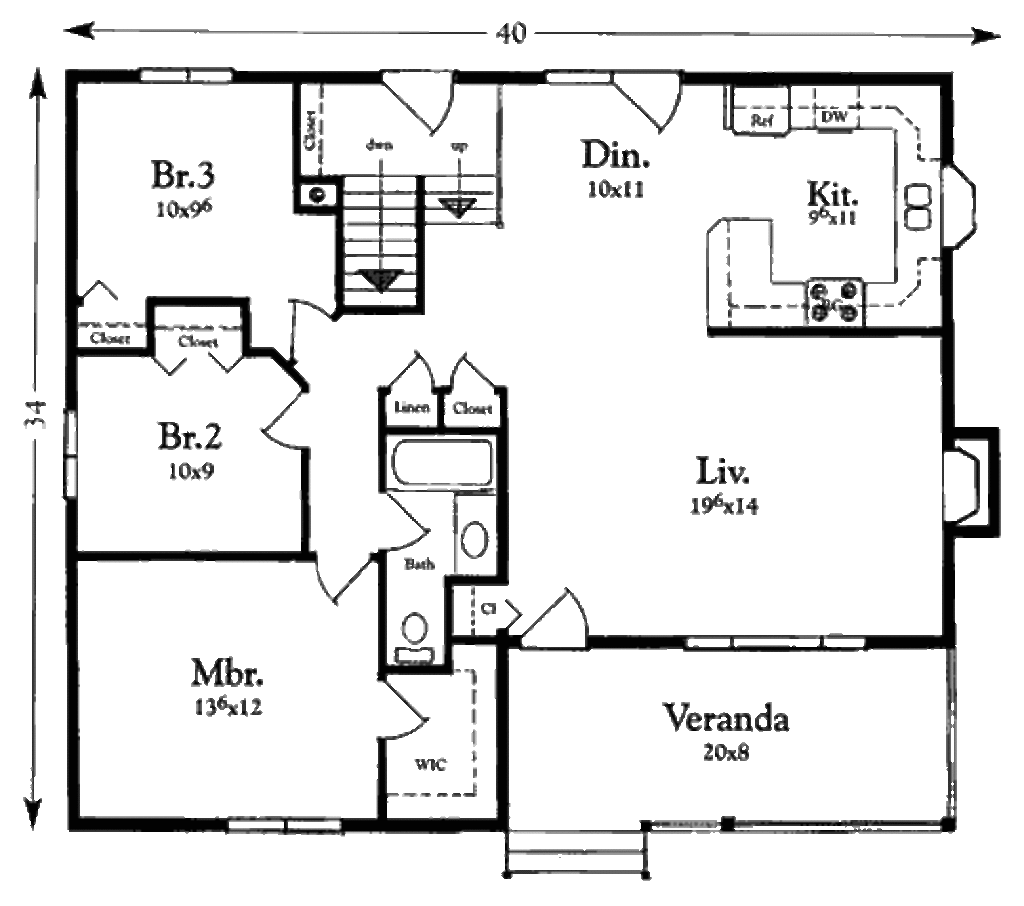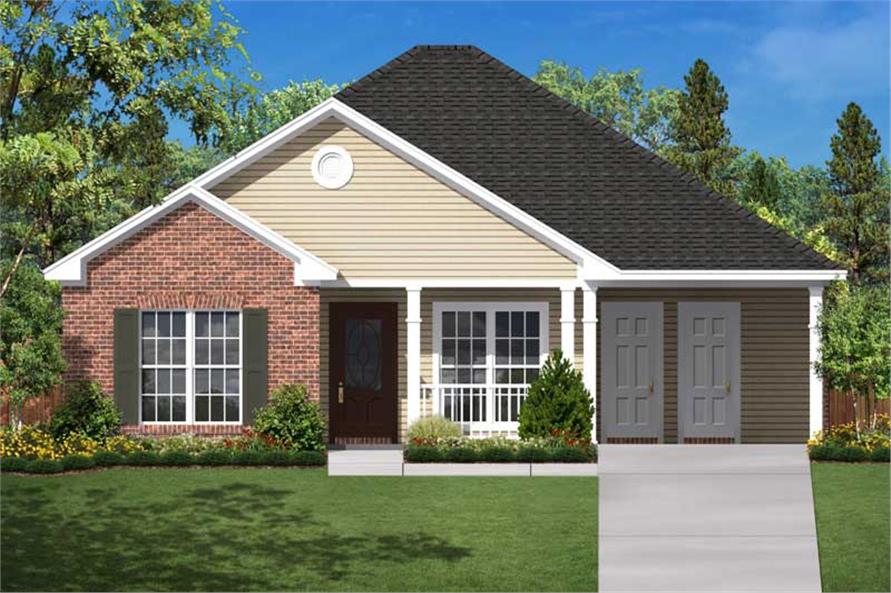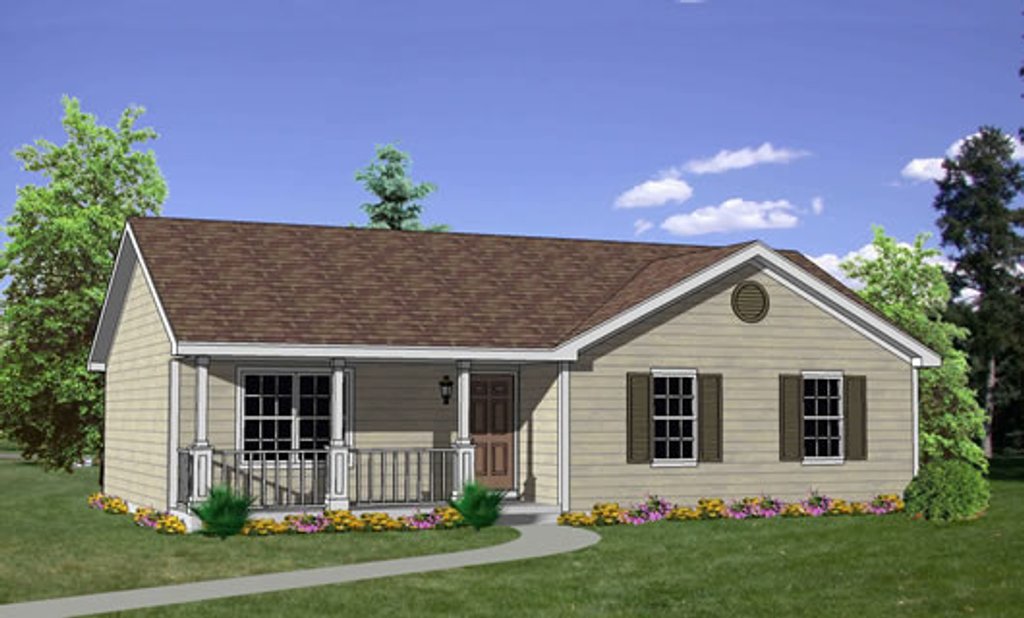Design Considerations for a 3 Bedroom 1200 sq ft House

A 1200 sq ft house plan provides a comfortable living space for a family. Designing a 3-bedroom home within this footprint requires careful consideration of layout, functionality, and maximizing every square foot.
Floor Plan Layouts
The layout of a 3-bedroom house significantly impacts its functionality and flow.
- Open Concept: This layout combines the living, dining, and kitchen areas, creating a spacious and airy feel. It’s ideal for entertaining and fostering a sense of togetherness. However, it may lack privacy and sound separation.
- Traditional: This layout features distinct rooms with defined walls, providing privacy and sound insulation. It may feel more formal and compartmentalized, but offers greater flexibility in terms of furniture placement and room use.
- Split-Level: This design separates the living areas from the bedrooms, often with a staircase connecting the two levels. It can create a sense of separation and privacy, especially for families with teenagers. However, it may require more stair climbing and can be challenging for people with mobility issues.
Key Features for a 1200 sq ft Home
Optimizing space and functionality is crucial in a 1200 sq ft house. Key features include:
- Efficient Kitchen Layout: A well-designed kitchen layout maximizes workspaces, storage, and traffic flow. Consider a galley kitchen, L-shaped kitchen, or a U-shaped kitchen depending on the available space and personal preferences.
- Multi-Functional Rooms: Incorporate multi-functional rooms to maximize space utilization. For example, a home office can double as a guest room, or a living room can incorporate a dining area.
- Built-in Storage: Maximize storage space with built-in shelves, cabinets, and closets. This helps to minimize clutter and create a more organized and spacious feel.
Maximizing Natural Light and Ventilation
Natural light and ventilation are essential for a comfortable and healthy living environment.
- Large Windows: Incorporate large windows to allow ample natural light to flood the interior. Position windows strategically to maximize sunlight throughout the day.
- Skylights: Consider skylights to introduce natural light into areas with limited window space, such as hallways or bathrooms.
- Cross Ventilation: Design the house plan with cross ventilation in mind. This involves positioning windows on opposite sides of the house to create a natural airflow.
Storage Solutions and Efficient Space Use
Storage solutions are critical for maintaining order and maximizing usable space in a 3-bedroom house.
- Under-Stair Storage: Utilize the space under the stairs for storage, creating a hidden compartment for items like seasonal decorations, tools, or extra linens.
- Murphy Beds: Consider Murphy beds in guest rooms or smaller bedrooms to maximize floor space. These beds fold down when not in use, providing a versatile solution for small spaces.
- Vertical Storage: Maximize vertical space by incorporating shelves, wall-mounted organizers, and hanging racks. This helps to keep belongings off the floor and creates a sense of openness.
Sample Floor Plan, 3 bedroom 1200 sq ft house plans
3 bedroom 1200 sq ft house plans – This is a sample floor plan for a 3-bedroom 1200 sq ft house, incorporating the discussed features. This is a general Artikel, and specific details should be adapted based on individual preferences and site conditions.
Three bedrooms, 1200 square feet – a modest canvas upon which to paint a life. But within that space, consider the possibilities: a sanctuary of warm wood and gentle light, where mornings begin with the soft caress of a natural wood bathroom double vanity and the day ends with the quiet reflection of your own reflection.
Such details, woven into the fabric of the house, transform it from mere shelter to a haven of comfort and quiet joy.
First Floor:
- Entryway: A small entryway with a coat closet provides a welcoming entry point.
- Living Room: A spacious living room with large windows and a fireplace creates a cozy and inviting atmosphere.
- Dining Room: A separate dining room can accommodate a table for six, providing a dedicated space for meals and gatherings.
- Kitchen: An L-shaped kitchen with ample counter space, cabinets, and a breakfast bar allows for efficient meal preparation and dining.
- Master Bedroom: A master bedroom with a walk-in closet and an en-suite bathroom offers privacy and convenience.
- Guest Bedroom: A guest bedroom with a built-in closet provides a comfortable space for visitors.
- Bathroom: A full bathroom with a bathtub and shower serves both the master bedroom and the guest bedroom.
Second Floor:
Three-bedroom, 1200 square foot house plans often prioritize space efficiency, making every inch count. This includes bathroom design, where considerations like the standard bathroom shower height are crucial. A well-planned shower, not only comfortable but also accessible, can significantly enhance the overall living experience within the confines of a 1200 square foot home.
- Bedroom: A third bedroom with a built-in closet provides additional sleeping space.
- Bathroom: A full bathroom with a shower serves the third bedroom.
- Laundry Room: A laundry room with a washer and dryer provides a convenient space for laundry needs.
Design Styles
Several design styles can be applied to a 3-bedroom 1200 sq ft house. Each style has its own unique characteristics and aesthetics.
| Style | Characteristics | Aesthetics |
|---|---|---|
| Modern | Clean lines, minimal ornamentation, open floor plans, natural materials, neutral color palettes. | Sleek, contemporary, minimalist, functional, light-filled. |
| Traditional | Formal, symmetrical layouts, detailed moldings, ornate furniture, warm color palettes, classic materials like wood and stone. | Elegant, timeless, comfortable, inviting, cozy. |
| Contemporary | Bold geometric shapes, asymmetrical layouts, innovative materials, vibrant color palettes, statement lighting. | Edgy, modern, dynamic, artistic, expressive. |
| Farmhouse | Rustic elements, exposed beams, reclaimed wood, natural materials, warm color palettes, comfortable furnishings. | Cozy, welcoming, casual, charming, relaxed. |
Popular 3 Bedroom 1200 sq ft House Plans

A 1200 sq ft house plan with 3 bedrooms offers a comfortable and functional living space for families and individuals alike. These plans come in various styles, layouts, and features to cater to diverse preferences and needs.
Popular 3 Bedroom 1200 sq ft House Plans
Here are some popular 3-bedroom 1200 sq ft house plans:
- Open Concept Floor Plan: This layout combines the living room, dining area, and kitchen into a single, spacious area, maximizing natural light and creating a sense of openness. This design is ideal for entertaining and fostering a sense of togetherness.
- Traditional Layout: This plan features separate rooms for each function, such as the living room, dining room, and kitchen. It offers privacy and a sense of formality, making it suitable for families who value distinct spaces.
- Split Level: This design incorporates two levels, typically with the bedrooms on the upper level and the living areas on the lower level. This layout offers separation and privacy, while also providing a unique architectural appeal.
- Ranch Style: This plan features a single-story layout with a low roofline. It is ideal for families with young children or those who prefer a comfortable and accessible living space.
Comparison of Popular 3 Bedroom 1200 sq ft House Plans
The choice of a 3-bedroom 1200 sq ft house plan depends on individual preferences and lifestyle needs.
| Plan Type | Pros | Cons | Suitability |
|---|---|---|---|
| Open Concept | Spacious, airy, great for entertaining | Lack of privacy, noise can travel easily | Ideal for families who enjoy open living and entertaining |
| Traditional | Privacy, formal spaces, well-defined areas | Can feel closed off, less flexible | Suitable for families who value distinct spaces and formality |
| Split Level | Separation and privacy, unique architectural style | Stairs can be challenging for some, less space efficiency | Ideal for families who value privacy and a distinct layout |
| Ranch Style | Accessibility, single-story living, comfortable | Limited space for expansion, less architectural variation | Suitable for families with young children or those who prefer single-story living |
Resources for Finding Inspiration
Several resources can help you find inspiration for your 3-bedroom 1200 sq ft house plan:
- Websites: Houzz, Pinterest, Architectural Digest, Dwell, HomeAdvisor, and Build.com offer a vast collection of house plans, design ideas, and inspiration.
- Books: “The Complete Book of House Plans” by David Vandervort, “The Homeowner’s Guide to House Plans” by John D. Bloodgood, and “The Complete Guide to Home Design” by Donna Griffith provide detailed information and design inspiration.
- Architectural Firms: Consulting with an architect or design firm can provide personalized solutions and tailored plans to meet your specific needs and preferences.
Layout of a Popular 3 Bedroom 1200 sq ft House Plan
The following is a detailed floor plan of a popular 3-bedroom 1200 sq ft house plan with an open concept layout:
[Insert floor plan description here]
Building and Budgeting Considerations for a 3 Bedroom 1200 sq ft House: 3 Bedroom 1200 Sq Ft House Plans

Building a 3-bedroom 1200 sq ft house is an exciting endeavor, but it’s essential to have a clear understanding of the financial implications involved. This section will delve into the estimated construction costs, budgeting tips, potential challenges, and a step-by-step guide to creating a realistic budget.
Estimated Construction Cost
The construction cost of a 3-bedroom 1200 sq ft house can vary significantly depending on several factors, including location, building materials, and construction methods. Here’s a breakdown of estimated costs based on common construction choices:
- Traditional Construction: This method utilizes wood framing, drywall, and traditional roofing materials. The estimated cost for a 1200 sq ft house in the United States ranges from $150 to $250 per square foot, depending on the region and complexity of the design. This translates to a total cost of $180,000 to $300,000.
- Prefabricated Homes: Prefabricated homes are built off-site and assembled on the building lot. This method can offer faster construction times and potentially lower costs. The estimated cost for a 1200 sq ft prefabricated home can range from $100 to $200 per square foot, resulting in a total cost of $120,000 to $240,000.
- Modular Homes: Modular homes are similar to prefabricated homes but are constructed in larger sections. They offer greater flexibility in design and customization. The estimated cost for a 1200 sq ft modular home can range from $120 to $220 per square foot, resulting in a total cost of $144,000 to $264,000.
Tips for Staying Within Budget
Building a house can be a complex and expensive project. However, with careful planning and execution, you can significantly increase your chances of staying within your budget. Here are some practical tips:
- Set a Realistic Budget: Start by establishing a firm budget based on your financial capabilities. Be realistic about your financial limitations and include a contingency fund for unexpected expenses.
- Choose Affordable Materials: Explore cost-effective building materials without compromising on quality. Consider alternatives like engineered lumber, vinyl siding, and composite roofing materials.
- Shop Around for Contractors: Obtain quotes from multiple reputable contractors and compare their pricing, experience, and references. Choose a contractor who aligns with your budget and project requirements.
- Consider DIY Projects: If you have skills and time, consider tackling some of the construction tasks yourself. This can help you save on labor costs, but ensure you have the necessary expertise and safety precautions in place.
- Prioritize Essential Features: Focus on essential features and postpone non-essential upgrades or additions until later. This can help you avoid unnecessary costs and maintain a manageable budget.
Potential Challenges and Solutions
Building a house involves numerous potential challenges, including permits, regulations, and site-specific factors. Here’s a discussion of common challenges and potential solutions:
- Permits and Regulations: Obtaining the necessary permits and complying with local building codes can be a time-consuming and complex process. Consult with your local building department early in the planning stage to understand the requirements and ensure a smooth permitting process.
- Site-Specific Factors: Site conditions, such as soil type, topography, and access, can significantly impact construction costs. Conduct a thorough site assessment to identify potential challenges and develop mitigation strategies. For example, if the site has a steep slope, you may need to consider retaining walls or other structural support measures.
- Unexpected Expenses: Unforeseen issues can arise during construction, such as hidden utilities or soil problems. Allocate a contingency fund of 10% to 20% of your total budget to address unexpected expenses.
Creating a Realistic Budget
Developing a comprehensive budget is crucial for successful home construction. Here’s a step-by-step guide to creating a realistic budget:
- Determine the Scope of Work: Clearly define the project scope, including the size of the house, desired features, and finishes. This will provide a foundation for estimating costs.
- Gather Cost Estimates: Obtain quotes from contractors, suppliers, and subcontractors for materials, labor, and permits. Request detailed breakdowns of costs to ensure transparency.
- Factor in Contingencies: Allocate a contingency fund of 10% to 20% of your total budget to cover unexpected expenses. This will help you avoid financial surprises and maintain a manageable budget.
- Review and Adjust: Regularly review your budget throughout the construction process. Adjust as needed based on actual costs and unforeseen expenses.
Formula for Estimating Total Construction Cost:
Total Construction Cost = (Cost per Square Foot x Square Footage) + Contingency Fund + Permits and Fees
